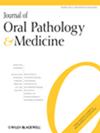Nonmetastatic Lymph Node Histological Architecture Is Associated With Metastasis, Recurrence, and Survival in Oral Squamous Cell Carcinoma
Abstract
Introduction
Oral squamous cell carcinoma (OSCC) is a common cancer, with a high propensity for regional lymph node metastasis (LnM), resulting in 5-year survival rates of only 40%–50%. The premetastatic niche (PMN), a modified lymph node microenvironment preparing for future metastasis, is poorly understood. This study analyzes the histomorphological features of nonmetastatic lymph nodes from OSCC patients, stratified by the presence or absence of regional cervical LnM.
Methods
This cohort study examined 424 nonmetastatic lymph nodes, preserved in paraffin blocks, from 45 OSCC patients. Histological analysis was performed using hematoxylin and eosin staining to evaluate architectural features, specifically capsule and trabeculae thickness, subcapsular and medullary sinus ectasia, fibrosis, follicular organization, and hyperplasia. Logistic regression models were used to assess the relationships between these features and LnM, recurrence, and survival.
Results
Our analysis revealed that intense medullary ectasia was associated with an increased risk of lymph node metastasis (LnM) (OR = 1.63; 95% CI: 0.99–2.67; p = 0.051), whereas follicular hyperplasia appeared protective (OR = 0.27; 95% CI: 0.15–0.5; p < 0.001). Nonvisible sinusoidal trabeculae suggested a higher risk of recurrence (OR = 2.18; 95% CI: 0.99–4.81; p = 0.05). Disorganized lymphoid follicles (OR = 1.91; 95% CI: 0.97–3.77; p = 0.059), focal subcapsular ectasia (OR = 4.4; 95% CI: 1.34–14.37; p = 0.014) and marked subcapsular ectasia (OR = 3.2; 95% CI: 1.06–9.63; p = 0.038) correlated with decreased survival. Conversely, follicular hyperplasia (OR = 0.38; 95% CI: 0.19–0.74; p = 0.005) and medullary fibrosis (OR = 0.13; 95% CI: 0.02–0.67; p = 0.015) were associated with improved survival.
Conclusion
These results highlight the potential clinical significance of follicular hyperplasia in lymph nodes. Patients exhibiting this feature may have a more favorable prognosis, characterized by increased survival and decreased risk of lymph node metastasis, regardless of concurrent alterations in other lymph node architecture.

 求助内容:
求助内容: 应助结果提醒方式:
应助结果提醒方式:


